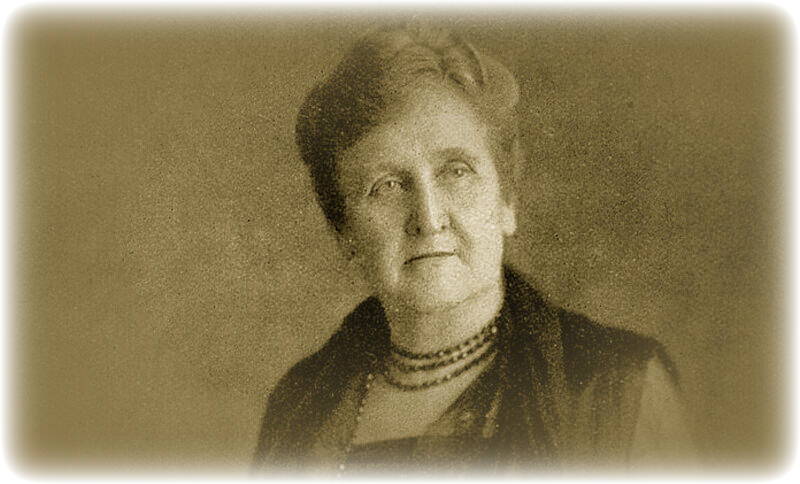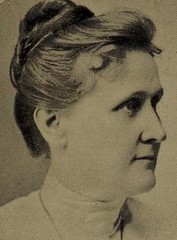
Leonora Evelina Simonds Piper (1859–1950) was a celebrated medium, known throughout her career simply as “Mrs. Piper.” Discovered by the family of William James and investigated by psychical researchers on both sides of the Atlantic, she provided some of the first good evidence for Survival After Death.
Leonora Simonds was born in Nashua, New Hampshire, on June 27, 1859. The first sign of her future career came when she was 8 years old and was playing in the garden. She suddenly felt a sharp blow to her right ear, accompanied by a hissing sound and then the words: “Aunt Sara, not dead, but with you still.” Terrified, she ran into the house in search of her mother who, besides comforting her, made a note of the day and time. Several days later they learned that Aunt Sara had died at that moment.
In 1881, when she was 22, Leonora Simonds married William Piper of Boston, by whom she was to have two daughters, Alta and Minerva. Alta was to write what is still the standard biography of her mother, The Life and Work of Mrs. Piper (1929). It is thanks to this book that much about her personal life is known.
According to Alta, the Mediumship began in earnest in 1884, after Piper’s father-in-law took her for a medical consultation to J.R. Cook, a blind clairvoyant who was becoming famous for his psychic diagnoses and cures. She lost consciousness and seems to have fallen into a trance herself. When she later attended Cook’s circle, she again fell into a trance, and wrote out a message for one of the other persons present. This was regarded by its recipient to be the finest he had received in 30 years’ experience in Spiritualism.
 Piper thereafter began to give private sittings in her home, to one of which she admitted William James’ mother-in-law, Alice Gibbons. Gibbons was so impressed that she convinced her daughter, James’s wife’s sister, to go. Finally, James himself went, with the intention, as he later admitted, of learning how the trick was done so that he could explain it to his in-laws. But the detailed knowledge Piper showed of his family stumped James. He made appointments for 25 of his friends, and thus began the research that was to continue for the remainder of Piper’s career.
Piper thereafter began to give private sittings in her home, to one of which she admitted William James’ mother-in-law, Alice Gibbons. Gibbons was so impressed that she convinced her daughter, James’s wife’s sister, to go. Finally, James himself went, with the intention, as he later admitted, of learning how the trick was done so that he could explain it to his in-laws. But the detailed knowledge Piper showed of his family stumped James. He made appointments for 25 of his friends, and thus began the research that was to continue for the remainder of Piper’s career.
James was in the perfect position to begin this research, because he was then (1885) involved in establishing the American Society for Psychical Research (ASPR) and was on the lookout for promising subjects. James secured from Piper the right to manage all of her sittings. He continued sending sitters to her for the next two years, then turned over responsibility for the investigation to Richard Hodgson, who had arrived from England to take charge of the ASPR.
Like James, Hodgson began his work with Piper assuming her to be a fraud. He had accused the Theosophist Helena P. Blavatsky of fraud and had become the scourge of English physical mediums; in the process he had learned a good deal about conjuring. He made appointments for 50 more sitters, keeping their identities secret from Piper; he began to keep detailed records of all her sittings; and he hired private detectives to have her followed. Although Piper behaved in no suspicious way, she continued to make remarkably accurate statements about people she had never met and about whom she had never even heard.
During this early period, Piper’s trance Control was an entity named “Phinuit,” who claimed to be a French doctor. Phinuit, however, knew little medicine and less French, and was unable to give a verifiable account of his supposed life on earth; his name (pronounced “Finney”) suggested he was modelled (unconsciously) after J.R. Cook’s control, who also was called “Finney.” Eleanor Sidgwick suggested that Phinuit was best considered a secondary personality, but a secondary personality endowed with considerable psychic talent. Phinuit was not who he said he was; but Piper, through Phinuit, was able to tell things about other people she had no normal way of knowing.
Piper’s talent was considered so extraordinary that a trip to England was arranged for her in 1889. Between November 1889 and February 1890 she held 83 sittings under the supervision of SPR investigators Frederic W.H. Myers, Sir Oliver Lodge and Walter Leaf. Although she was in a place she had never been before, was closely watched, and consented to have her mail opened, Mrs. Piper continued to perform with astonishing success.
Hodgson published a cautious report on his work with Mrs. Piper in the SPR’s Proceedings in 1892, but he followed this in 1898 with his conversion to the survival hypothesis.
In 1901 the New York Herald carried a story by Mrs. Piper headlined “Mrs. Piper’s Plain Statement” and often referred to as her “Confession.” Although it is sometimes said she “confessed” to fraud, Piper in fact wrote only that she could not be sure that spirits were controlling her; she tended to believe that she got her information by Extrasensory Perception (ESP). This, indeed, was the major interpretive question about her Mediumship (and about all mediumship), and psychical researchers were—and are—to be found on both sides themselves.
With Hodgson’s sudden death in 1905, a crisis arose concerning the voluminous Piper records. Because the SPR had sponsored most of the research, they claimed them; but because the records contained so much personal information, American sitters were reluctant to let them go. James H. Hyslop, who replaced Hodgson at the helm of the ASPR, fought hard to keep the records in the United States, but lost the battle.
In 1906 Piper made a second trip to England, this time to participate in the complex network of mediumistic communications known as the Cross Correspondences. Her contributions, as usual, were outstanding.
Unfortunately, Piper’s sittings after she returned to the United States in 1908 were badly managed. The psychologists G. Stanley Hall and Amy Tanner were allowed to experiment with her during this period, which lasted into 1909. (Tanner describes this work in her 1910 book, Studies in Spiritualism.) Sittings were devoted largely to personal matters, sitters were left unsupervised, and records were not systematically taken. Piper also was subjected to extremely harsh treatment, evidently in order to test the depth of her trance. Among other results, her daughter Alta stated, was a “badly blistered and swollen tongue which caused Piper considerable pain and inconvenience for several days.”
Due to the treatment she received at this time, Piper suffered a temporary suspension of “power” that lasted well into her third and last trip to England, in 1909– 1911. When the mediumship resumed, it was in the form of Automatic Writing rather than trance (her trance was never to return). Piper was once more briefly in her old form, but after she returned to the United States in 1912, she ceased working for more than 10 years. She held a few sittings with Gardner Murphy in 1924 and agreed to a contract with the Boston Society for Psychic Research in 1926 and 1927, but then retired for good.
Piper died on July 3, 1950, at the age of 91. A medium of the first rank, she had given much of her life unstintingly in service of science, and as a result many who had previously doubted the possibility of survival after death became convinced of its actuality. These included Hyslop in addition to Hodgson. William James also may have been persuaded, although he never said so publicly.
Another part of Piper’s legacy is even more important. Prior to her discovery psychical research had concentrated on physical mediums, the vast majority of whom were exposed as frauds; but after Piper the interest shifted to mental mediums, and she had equally important successors (see Eileen J. Garrett; Gladys Osborne Leonard; Minnie Meserve Soule).
SEE ALSO:
FURTHER READING:
- Gauld, Alan. The Founders of Psychical Research. London: Routledge & Kegan Paul, 1968.
- —. Mediumship and Survival: A Century of Investigations. London: William Heinemann, Ltd., 1982.
- Matlock, James G. “Leonora or Leonore? A Note on Mrs. Piper’s First Name.” Journal of the American Society for Psychical Research (SPR)82 (1989): 281–90.
- Piper, Alta L. The Life and Work of Mrs. Piper. London: Kegan Paul, 1929.
- Tanner, Amy, and G. Stanley Hall. Studies in Spiritualism. New York: Appleton, 1910.
SEE ALSO:
SOURCE:
The Encyclopedia of Ghosts and Spirits– Written by Rosemary Ellen Guiley – September 1, 2007
